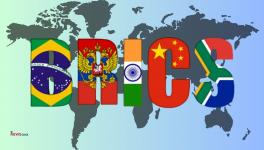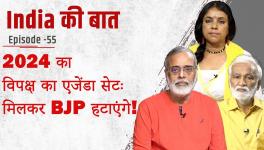National IPR Policy: What Does it Hold for the Country?
Newsclick interviewed Dinesh Abrol, National Working Group on Patent Laws and WTO to get to know the nuances of this new policy and its implications.
The Union government recently came out with the national intellectual property policy, which is touted as a mechanism to promote entrepreneurship and innovation in India. Will this policy really do it? Or is really counter-productive to an innovation led economy, which India has been thriving to be? What does the government want to do with this policy?
“An India where creativity and innovation are stimulated by Intellectual Property for the benefit of all; an India where intellectual property promotes advancement in science and technology, arts and culture, traditional knowledge and biodiversity resources; an India where knowledge is the main driver of development, and knowledge owned is transformed into knowledge shared,” the policy vision statement says.
Rough Transcript:
Prabir Purkayastha (PP): Hello and welcome to Newsclick. Today we have with us Dinesh Abrol from the National Working Group on Patents. We have now the national IPR policy, Intellectual Property Rights policy. It seems to be geared exclusively on the basis of knowledge being privatized as only road to innovation.
DineshAbrol (DA): If you look at the policy as it have seven objectives and the seven objectives, you can also see references to open source and FOSS, drug discovery. But those are actually a lip service only paid to those paths or those routes to development of innovation. Essentially, the focus and the thrust of the is on exactly what you are saying that IP is considered as a private right, is considered as a basis for all innovation and they want to maximize the incentive to the IP owners in any form of IP because this is India's first of it's kind policy which covers all the forms of IP together using one set of principles and the principles are are clearly tilted in favour of IP owners.
PP: It also talks about how the government and public institutions universities and so on. Government research institutions must also incentivise IP and intellectual property that means all publicly funded research output should also be privatized. That seems to be again what other part of this policy is saying and there are various places it refers to the need to create intellectual property for the universities and public fund which have been given to them to the research institutions which means public funds again been given and it does not seem to believe that if it is publicly funded then the result should also benefit the public.
(DA): You and me were both involved in stalling the Indian version of the bayh dole act act because we believed in India not going for intellectual route of property route of that kind the bayh dole version suggested in the case of public sector research.
PP: The bayh dole actact means the US act to attempt to really privatize the public funded research that was the first of it's kind in that sense as a model which was used.
DP: Though we could stalled it but I think whether it will come back or not is any body's guess. But what appears is the kind of emphasis is you yourself has just now suggested is taking in the respect of public sector research institutions whether universities or other they really want to go in the direction actually. These institutions being encouraged to file their patents, license them in an exclusive way rather than non-exclusive way and if you look at the experience of the CSIR was one of the first few research councils in India under Mashelkar's leadership to actually say that move away from publishing and move to patents as a form and also wanted to move into the exclusive licensing of intellectual property and that's what has been practiced. But if you look at the results, the outcome of that particular policies, it has costed the exchequer the treasury quite a lot and we have not been able to use many many patents and only 4% of the cost have been possibly finally realized in the form of revenue. But more importantly if you look at the failures of the sources of this failure because there is no planning of actually R&D for technology development to the extent that when you are wanting yourself insert yousrsel to the overall intellectual property system that's why you know the attempt itself was very very weak with regard to and I don't see if somebody suggest okay fine public sector research institutions can use patenting. They used actually at one time. But they used at very differently like process patent used to be filed in the case of CSIR but Indian Pharmaceutical industry grew without actually technology being licensed to them. It was shared through actually transfer of personnel.
PP: But coming back to other issue when you look at countries which are developed late developers which is what we are at the moment. Late developers have always been much more open and not taking the patents route. It's the incumbent, the monopolies, the older countries who hold the bulk of the patents. England at one point of time. The US at that point of time used to really now it would be called pirating which they call pirating now. This whole issue does mean that if you are a strong developed countries with lots of monopoly rights technology and what a new developing country does are quite different?
DA: You are very right in fact strong IP barrier to collaboration between science and industry. In fact, that's what the experience of both seed industry in India as well as the pharmaceutical industry indicates very clearly. Collaboration between the 18 laboratories of the CSIR and Indian pharmaceutical industry are cutting absence of product patent or a patent system which actually provided for license of rights. Automatic license of rights as well. So in fact, in very few cases you know as I said earlier to you that licensing route was used but even when it was used it did not mean much cause. There was openness and same is the case with the seed industry also.
PP: Also the software industry which is really grown initially including Microsoft and Google which is supposed to be the big ones have really grown under really no patent of software.
DP: Look, if you look at micro processor integrated circuts, so America chip design act was not there. It came much later when these technologies were evolving foundational elements today ICT, the information communication technology. Software grew under copyright upto some extent initially. There was no patent at that time as well and the copyright is very different let's say system compared to patent. The stronger IP was not the basis for development of any of the new generic technologies.
PP: So the whole argument of this policy document that IP fosters innovation is in principle wrong and that's the historical experience that we have. So it seems to have been more done to help what US trade representative wanted that India should have a 'strong' IP regime and that's what they have been pressing for including changes in laws and this document also talks about possible changes in the domestic laws. That's a very significant danger signal to the pharmaceutical industry and the famous 3D clause of the patent act.
DA: Now before I come to the issue of how it is a gift to the US administration because Modi is visiting the US on 7th June and 8th we will come to that issue. I want to mention, if you look at the experience of the Indian pharmaceutical industry post 1995 I just now analyzed 262 drugs which have been introduced since 1995. it is really the delayed product patent which has saved us because we implemented product patent with the help of the left support the UPA 1 was supported from outside in 2000, in 1996
PP: Left's pressure to change the patent amendment which came in 2005.
DA: Now, in fact the foreign firms have the market power has reason over period as far as concerned but the results could have been worse if you compare with the Latin American experience has because they did early implementation of TRIPS. They did it actually from 1995 onwards. All the Latin American countries their industry did not take the benefit of the hatch waxman act act which could not build a generic industry. India could build a generic industry because precisely because we had that space. The space was created precisely by more balanced IP system with which we through struggle created in India. If you go by that experience of the post 1995 period, the innovation or capability development has not occurred on account of strong IP. So even the recent experience, forget about international experience of other technologies which we were talking of and now of course you are bringing in 3D printing. The India's own experience very very clear as far as pharmaceutical industries is concerned, the strong IP is not in the interest in the areas where product patent where hence patentable from post 2005 onwards the many areas we see, many many therapeutic groups are in the eyes of the market...whether it is anti-cancer, cardio vascular, the urology, the CNS systems many these areas what is happening.
PP: Coming back as you were saying about gift to the United States this opening or presenting this presenting IPR policy at this particular point of time is really to make grounds for 'triumphal visit by Modi' to the United States, it is a gift to the United States. How do you look at that?
DA: Let's read it in the context of two developments one is mega regional, Nairobi has failed. India do not play it's role as far as Nairobi is concerned. We had earlier a discussion, WTO discussions and the US could push the case for a new issues, 21st century issues. But outside as you know the WTO they have been pursuing mega regional TPP, Trans Pacific Partnership, the TTIP and also together ASAP is being regional cooperation economic partnership is being also pursued. Now, if you talk to the ministry officials, several seminar and conferences on trade and investment and one has been directed with them, it said India can not remain outside the mega region. So like the TINA syndrome, so there is no alternative as far as this is concerned we are willing to go into mega-regional. But mega-regional represents TRIPS plus plus provisions. They allow patents for new uses for drugs for example which we rejected in the Indian patent act.
PP: The patent act has to be revised. And that's the implication of. .. and that's also the policy document says clearly.
DA: Precisely, and they say that we are willing to engage with multilateral treaties with India because they are in India's interest of course they have put it that way and they are also are saying that if law needs to be changed, they can be changed.
PP: They will change the Indian acts. So we seem to have given some assurances of future change of act which is what is contained in the law and that's a prelude do you think Mr. Modi's visit to the United States?
DA: See, immediately we will see any change in the law as far as I understand. But if you look at quality of the patents which should have been actually targeted, section 3D in fact there is a study which is already available is not being implemented by the examiners properly because examiners themselves are not very trained and also there are other points which continuously gets made is that there is not enough examiners and they are going to raise the issue as not just more examiners the question is also quality of the patents needs to be checked consciously. But if the policy gives the signal that more patents, more innovation then you won't be able to focus on quality of the patents.
PP: Dinesh, the last point that this government seems to be moving in the direction and Mr. Jaitley's statement while releasing the policy is that we need to help big capital in India and that's why the IPR policy has to change to take care of that. So this is a conscious effort to move this whole patent regimes to help the capital and that would also be an increase in drug prices, the increase in other prices to the consumers. So it is really moving against the consumers, against the poorso help the big businesses. That will be the way you read this?
DA: See if you heard Jaitley and releases particularly he paid lip service to the fact that drug prices should be controlled and so on etc and India needs cheaper drug and so on. But if you look at the other statement which he made in that particular press conference that Trademark registration would be accelerated and would be very easy. The ease of business, ease of trademark registration. He emphasized that, that's one of the benefit that you are going to derive out of this. And if you look at even at the last, we have not even filed too many patents as far as Indian creativity and innovation which is actually being thought of should needs to be protected. There isn't at that moment much of the activity which can even protected. What we have seen is rise of trademark applications and the trademark applications are maximum in the area of medicinal areas. So it is through the brand name that the monopoly is built and it is through the trademark you see on the top of the patent also the more profits are obtained and the prices are raised and so on
PP: This is all the time we have today. Keep watching Newsclick for further developments.
DISCLAIMER: Please note that transcripts for Newsclick are typed from a recording of the program. Newsclick cannot guarantee their complete accuracy.
Get the latest reports & analysis with people's perspective on Protests, movements & deep analytical videos, discussions of the current affairs in your Telegram app. Subscribe to NewsClick's Telegram channel & get Real-Time updates on stories, as they get published on our website.
























